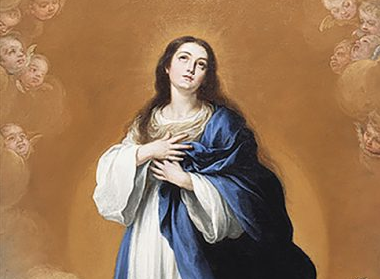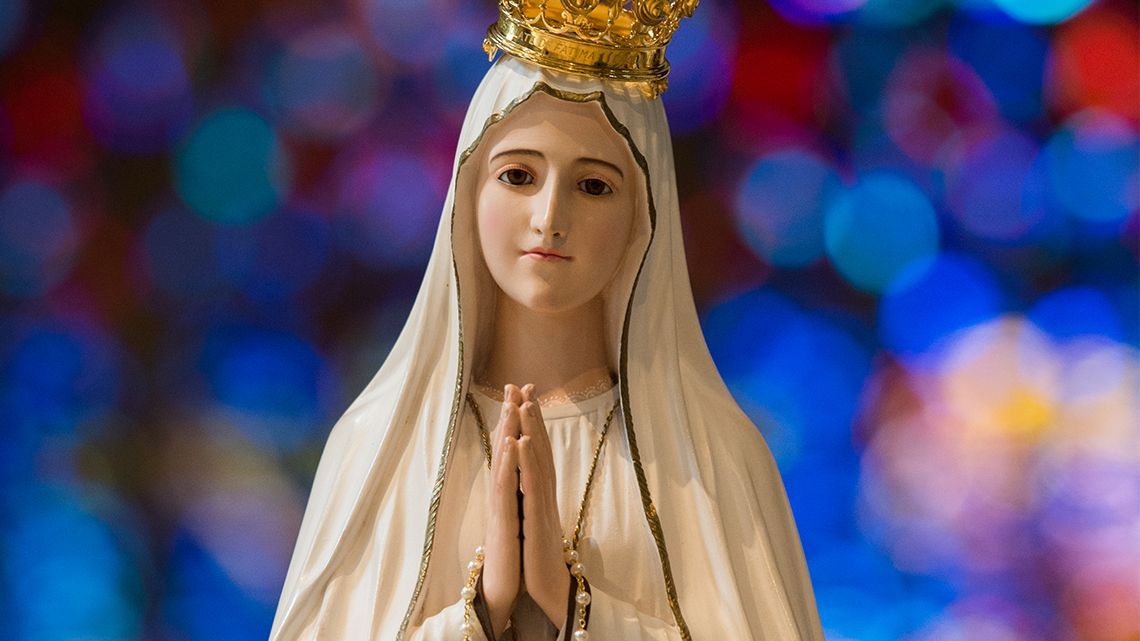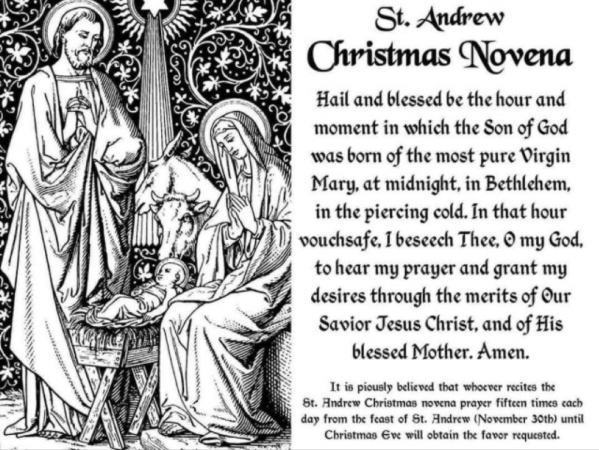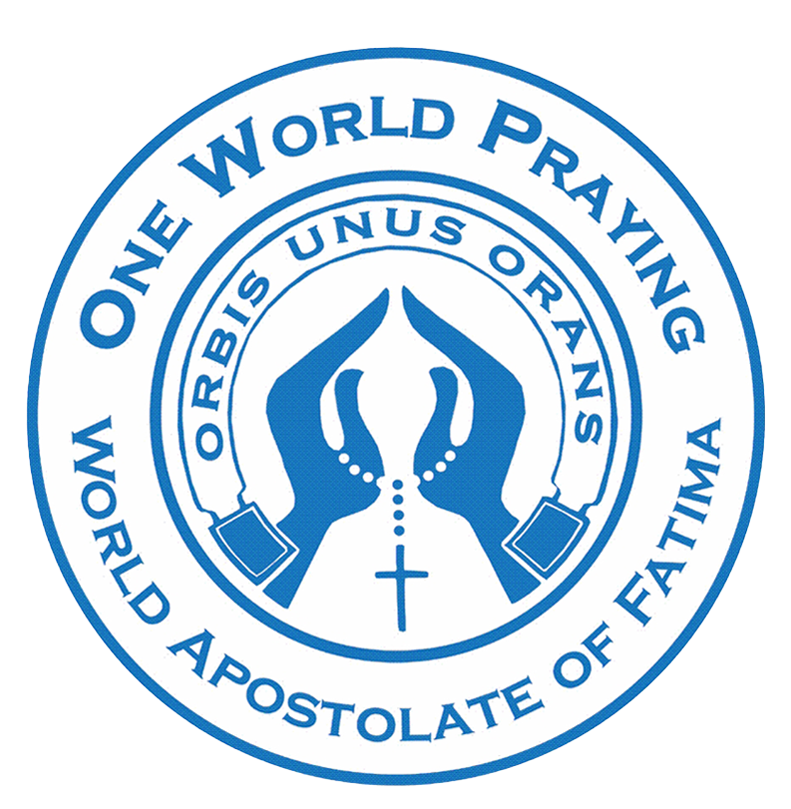
The Consecration to the Holy Family is a devotion in which we entrust our homes to Jesus, Mary, and Joseph, asking for their protection and guidance. It invites our families to grow in holiness and unity by following the example of the Holy Family The Consecration to the Holy Family is a meaningful devotion through which we, as Catholics, entrust our homes to Jesus, Mary, and Joseph. Though love for the Holy Family has been part of the Church’s life from the earliest centuries, the more formal practice of consecrating families to them grew significantly in recent times. In 2018, the Knights of Columbus began widely promoting this devotion to strengthen Catholic family life and help households embrace their identity as “domestic churches.” This modern initiative builds on a long tradition encouraged by Popes Leo XIII , Benedict XV , and others, who urged Catholics to look to the Holy Family as the model of unity, virtue, and holiness. How do we make the Consecration to the Holy Family? Families are encouraged to prepare spiritually by attending Mass, praying together, reflecting on the virtues of the Holy Family, and receiving the Sacrament of Reconciliation when possible. On the day of consecration, the family gathers—either at home or during a parish celebration—and prays the official Prayer of Consecration to the Holy Family . This prayer entrusts the family to Jesus, Mary, and Joseph, asking for their protection, guidance, and help in living out the Gospel within the home. Many families also place an image of the Holy Family in a prominent place as a reminder of their commitment. Which consecration prayer formula do we use? Most parishes today use the prayer provided by the Knights of Columbus , which is the standard and widely recognized Prayer of Consecration to the Holy Family . Because it is copyrighted, it is usually not printed in full without permission—but it is commonly available in parish bulletins, on Knights of Columbus materials, and on their official website. The prayer includes elements such as: dedicating the family to Jesus, Mary, and Joseph; asking for protection from spiritual and worldly dangers; a commitment to imitate the virtues of the Holy Family; and a pledge to strengthen faith, prayer, and unity within the home. Your parish may also provide an approved version of the prayer, and any formula officially recommended by the parish or diocese is entirely appropriate to use. By making the Consecration to the Holy Family, we unite ourselves to the perfect example of Jesus, Mary, and Joseph. In a world where family life often faces many challenges, this devotion gives us a spiritual foundation rooted in faith, love, and mutual sacrifice. May the Holy Family watch over our homes and guide us ever closer to Christ.
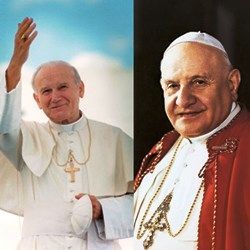
Some quotes from Popes and Saints about Advent St. Ambrose of Milan: “Open wide your door to the one who comes. Open your soul, throw open the depths of your heart to see the riches of simplicity, the treasures of peace, the sweetness of grace. Open your heart and run to meet the Sun of eternal light that illuminates all men” St. John Chrysostom: “Let us prepare for the coming of our Lord with repentance, humility, and acts of charity, for through these the soul adorns itself for the King.” St. Alphonsus Liguori: “During Advent, we learn how to die to ourselves so that Christ may be reborn in our hearts.” Pope Leo XIII: “The progression of the Advent season is like the increasing light from the dawn until the rising sun; we must let this light ignite the flame of charity in our souls.” Pope Pius XI: “Advent is that time of year when the Church prepares herself spiritually for the coming of the Redeemer, the long-awaited Messiah, who brings light into the darkness of the world.” Pope Paul VI: “Let Advent be a spiritual journey toward the Christmas mystery, where there will be found a humble manger, a child who is God himself. Let us prepare ourselves to receive him fully in our hearts.” St. Teresa of Calcutta: “Are we ready to receive Him? Before the birth of Jesus, His parents asked for a simple dwelling place, but there was none. If Mary and Joseph were looking for a home for Jesus, would they choose … your heart, and all it holds? Let us pray that we shall be able to welcome Jesus at Christmas...” St. Pope John Paul II: “Mary sustains our journey toward Christmas, for she teaches us how to live this Advent Season in expectation of the Lord.” Pope Benedict XVI: “Advent is the spiritual season of hope par excellence, and in this season the whole Church is called to be hope, for itself and for the world”.
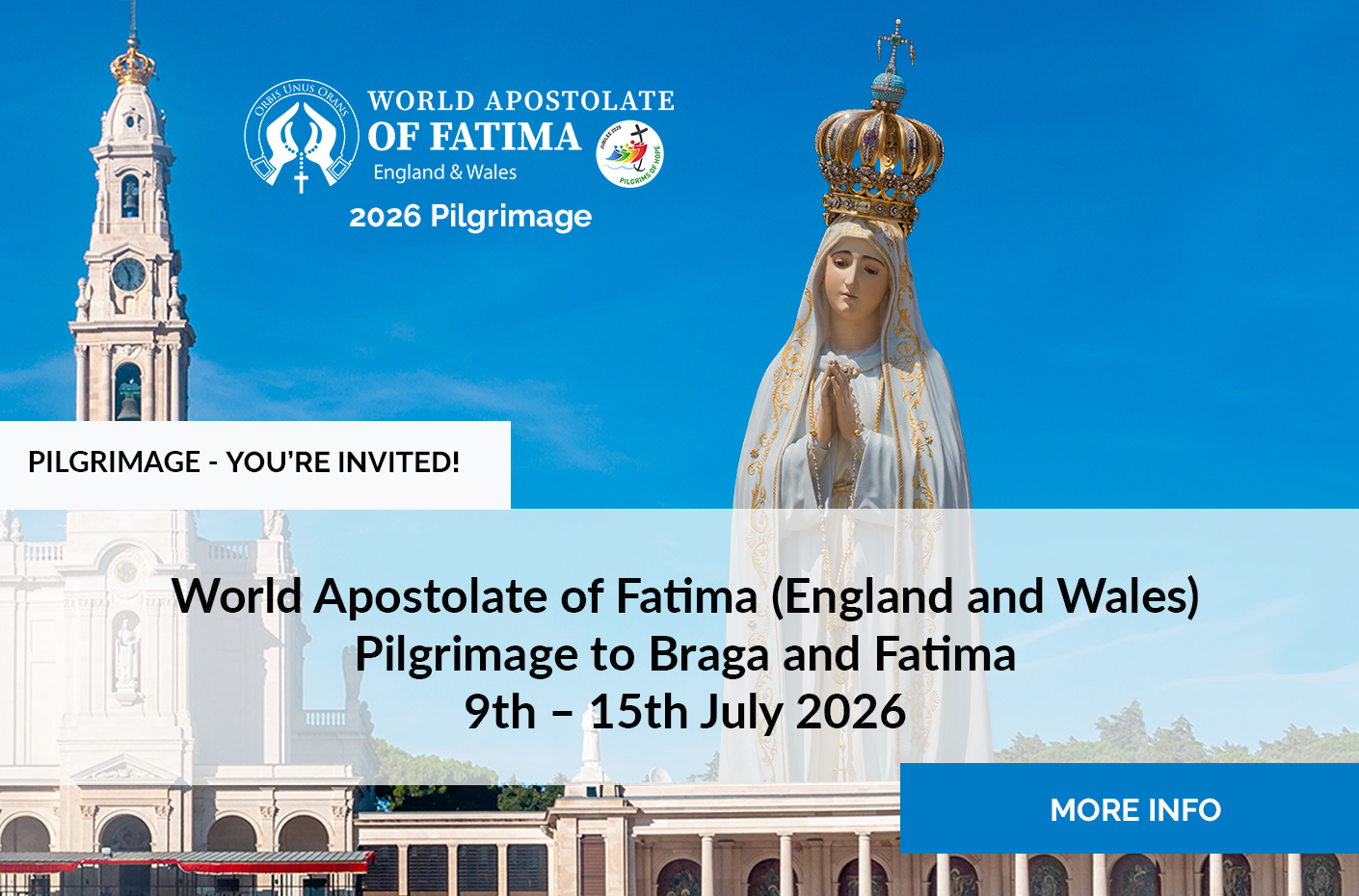
World Apostolate of Fatima (England and Wales) Pilgrimage to Braga and Fatima 9th th – 15 th July 2026 Day one - Thursday 9 th July 2026 (London-Porto-Braga) Flight from UK to Porto. (LGW/Porto – Easyjet 1005 / 1300) Meet our coach and guide and transfer to our accommodation in Braga. Time to see Braga. Dinner is provided at the hotel. Day two – Friday 10 th July 2026 (Braga-Balazar) After breakfast we begin our visit to the city of Braga and the Shrine of Sameiro and Bom Jesus. We break for lunch. In the afternoon pilgrimage to Balazar to pray at Blessed Alexandrina’s tomb. Mass in the chapel. Dinner and overnight accommodation at our hotel. Day three – Saturday 11 th July 2026 (Porto-Aveiro-Coimbra-Fatima) After breakfast we check out of our hotel in Braga and travel by coach to Porto. Free time to tour the city in the morning and enjoy lunch. In the afternoon we travel towards Fatima, stopping en route in Aveiro. We travel on to Coimbra and visit the Museum of Sister Lucia and say Rosary at the Convent Chapel. Check in at Domus Pacis hotel in Fatima and dinner. Day four – Sunday 12 th July 2026 (Fatima) Breakfast in the hotel Holy Mass in Domus Pacis or Shrine. We then have free time to independently tour the Sanctuary. Free for lunch. Visit to the House of Candles for a guided tour. 7.30 pm - Dinner at the hotel 9.30 pm - Participation in the evening Vigil We return to our hotel for our overnight accommodation. Day five – Monday 13 th July 2026 (Fatima) After breakfast we join the congregation for the International Mass in the Piazza of the Shrine of Fatima. Free for lunch 2.30 pm – We meet for talk of Nuno and Ana at Domus Pacis Chapel. 4.00 pm - Visit to the museum of Fr Formigao. 6.00 pm Fatima Prayer Cell at the Library of Domus Pacis. 7.30 pm Dinner 9.30pm Rosary and Candlelight procession Day six – Tuesday 14 th July 2026 (Fatima) After breakfast we depart by coach walk the Stations of the Cross. We visit the site of the Apparition of the Angel and celebrate Mass at St Stephen’s chapel. We then walk into the village of Aljustrel where we break for lunch before visiting the homes of the children. We return by bus to St Anthony’s Church for a renewal of baptismal promises. Return to the hotel. 7.30 pm Dinner 9.30pm Rosary and Candlelight procession Dinner and overnight accommodation in Fatima. Day seven – Wednesday, 15 th July 2026 (Fatima-Lisbon) After breakfast we check out of our hotel and depart for Lisbon. En route we visit Santerem before moving on to the Shrine of St Anthony where we celebrate Mass. We also visit the Convent of the Poor Clares where Jacinta stayed whilst waiting for a hospital bed. We travel on to the airport for our return flight to the UK. (1720/1955 LIS/LGW)Day 1 – Thursday, 9 July (London–Porto–Braga) Flight from London Gatwick to Porto. Transfer to Braga with time to explore the city. Dinner at the hotel. Day 2 – Friday, 10 July (Braga–Balazar) Visit Braga’s religious sites: Shrine of Sameiro and Bom Jesus. Afternoon pilgrimage to Balazar to pray at Blessed Alexandrina’s tomb. Mass and dinner at the hotel. Day 3 – Saturday, 11 July (Porto–Aveiro–Coimbra–Fatima) Travel to Porto for sightseeing and lunch. Continue to Fatima via Aveiro and Coimbra. Visit Sister Lucia’s museum and pray the Rosary. Check-in and dinner at Domus Pacis hotel. Day 4 – Sunday, 12 July (Fatima) Mass at Domus Pacis or the Shrine. Free time to explore the Sanctuary. Guided tour of the House of Candles. Dinner and participation in the evening vigil. Day 5 – Monday, 13 July (Fatima) Attend the International Mass at the Shrine. Afternoon talks and visits: Domus Pacis Chapel, Fr Formigao Museum, and Fatima Prayer Cell. Evening Rosary and Candlelight procession. Day 6 – Tuesday, 14 July (Fatima) Stations of the Cross and Mass at St Stephen’s Chapel. Visit Aljustrel village and homes of the visionaries. Renewal of baptismal promises at St Anthony’s Church. Dinner and evening procession. Day 7 – Wednesday, 15 July (Fatima–Lisbon) Depart for Lisbon with stops at Santerem and the Shrine of St Anthony. Visit the Convent of the Poor Clares. Return flight to London Gatwick. Price: £1,370 per person sharing a twin/double room on a half board basis. Single rooms are available at a supplement of £190. Price includes return airfare including hold baggage, accommodation as detailed in the itinerary, all transport whilst in Portugal, and all entrance fees. Price does not include lunches, drinks or items of a personal nature. Please note that this itinerary is not suitable for the less able traveller. Deposit of £400 and completed booking form required by 15.12.2024 with balance and any single supplement due by 16.4.2026. Booking Ref: WAF02
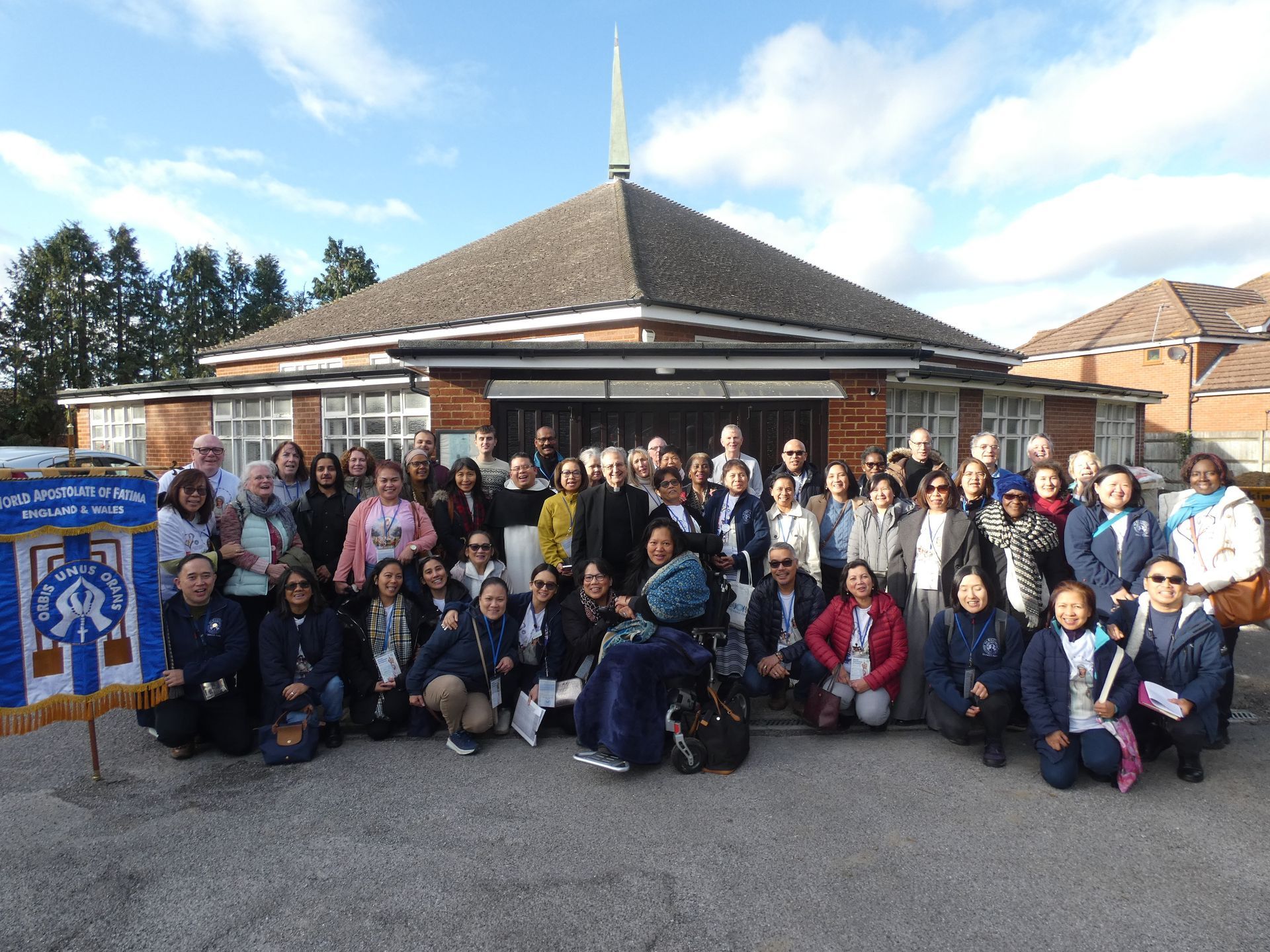
The 8th Annual General Meeting of the World Apostolate of Fàtima England and Wales took place from 23-25 October 2025. This three-day event was a time of reflection, gratitude, planning, and prayer to strengthen the Apostolate’s mission of spreading Our Lady of Fàtima’s message across England and Wales. On Day 1, participants engaged in discussions focused on Promoters’ growth and contributions, Social Media and newsletters, and the Children of the Eucharist and Young Missionaries of Mary programs. Day 2 featured talks by two invited speakers: Antonia V Moffat on the connection between Consecration requests and the First Saturdays of Reparation, and Fr Lawrence Lew, OP, on the powerful theme of Redemptive Suffering in Fàtima’s message. The new Trustees elected were Ethel Lojo as National Treasurer and Anthony Hanley as a Board Member. Day 3 included an insightful session with Jerry Rivera about the Fàtima Prayer Cell program, which has been running for over four years. The event was led by National President Patrick Cunningham and Vice President Barbara Dixon, supported by National Secretary Kathleen Too, Aurea Ancheta Coloma, and Lucila Salonga Desbruslais. A special thanks was extended to Rev Fr Peter Sebastian, who celebrated the liturgies and hosted the AGM in his parish. The 9th Annual General Meeting will be held in November 2026, with details to be announced. May Our Lady’s Immaculate Heart be your refuge and guide you to God. Ave Maria.
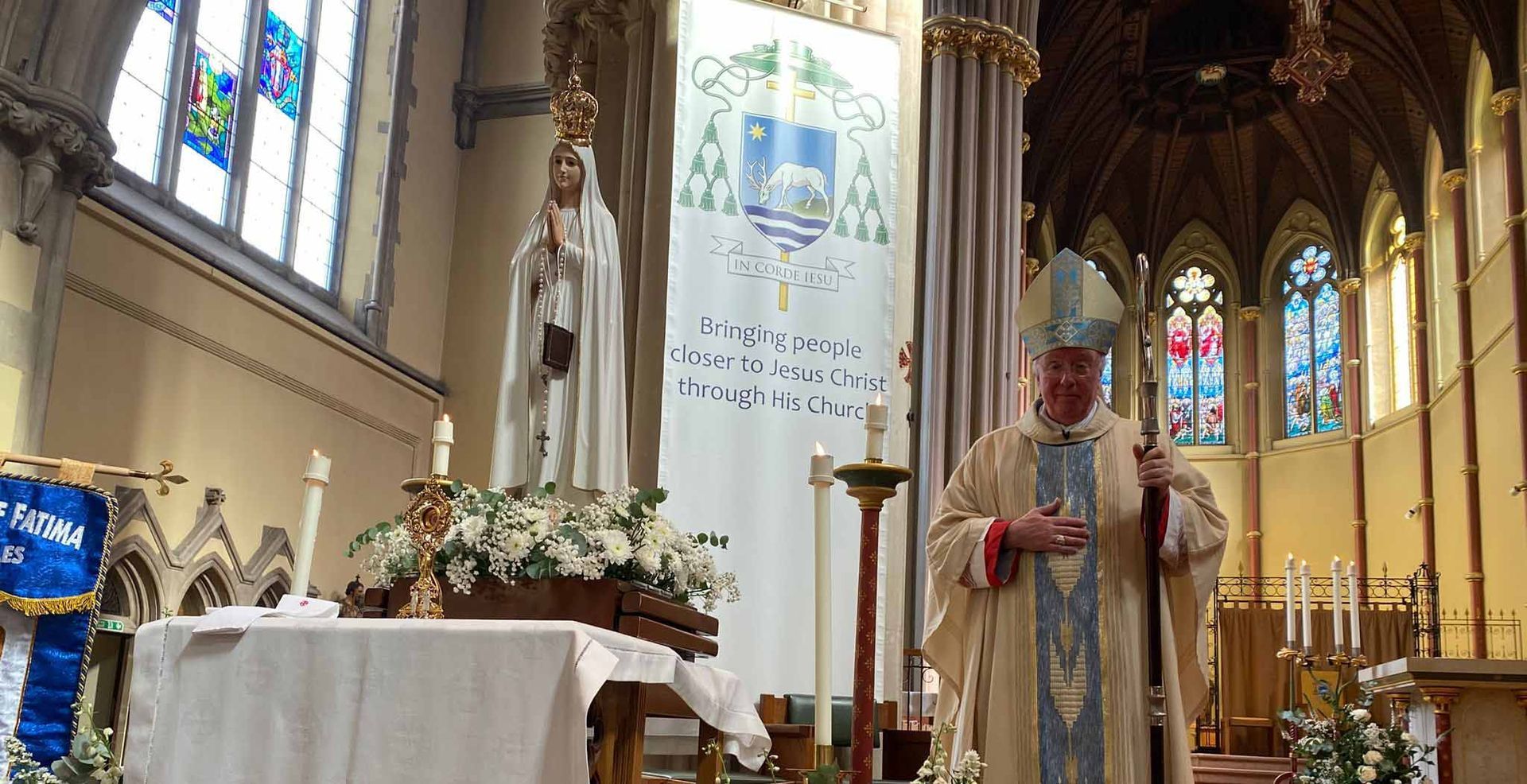
On the first Saturday of October, the National Pilgrim Virgin Statue (NPVS ) of Our Lady of Fàtima and the Relics of Saints Francisco and Jacinta Marto visited the Cathedral of St John the Evangelist in Portsmouth. Bishop Philip Egan welcomed, crowned, and blessed the statue, relics, and the Centenary Icon of the Pontevedra apparition during Mass, attended by about 200 faithful from across the diocese. In his homily, Bishop Philip emphasized the Immaculate Heart of Mary and her call for conversion and reparation. He also led a 15-minute meditation and the recitation of the Joyful Mysteries of the Rosary. Canon James McAuley, Cathedral Dean and Vicar General, guided the veneration of the relics and welcomed the congregation. Fr Ryan Browne, the cathedral curate, presided over the enrollment and investiture of brown scapulars. May Our Lady's Immaculate Heart be your refuge and guide you to God.
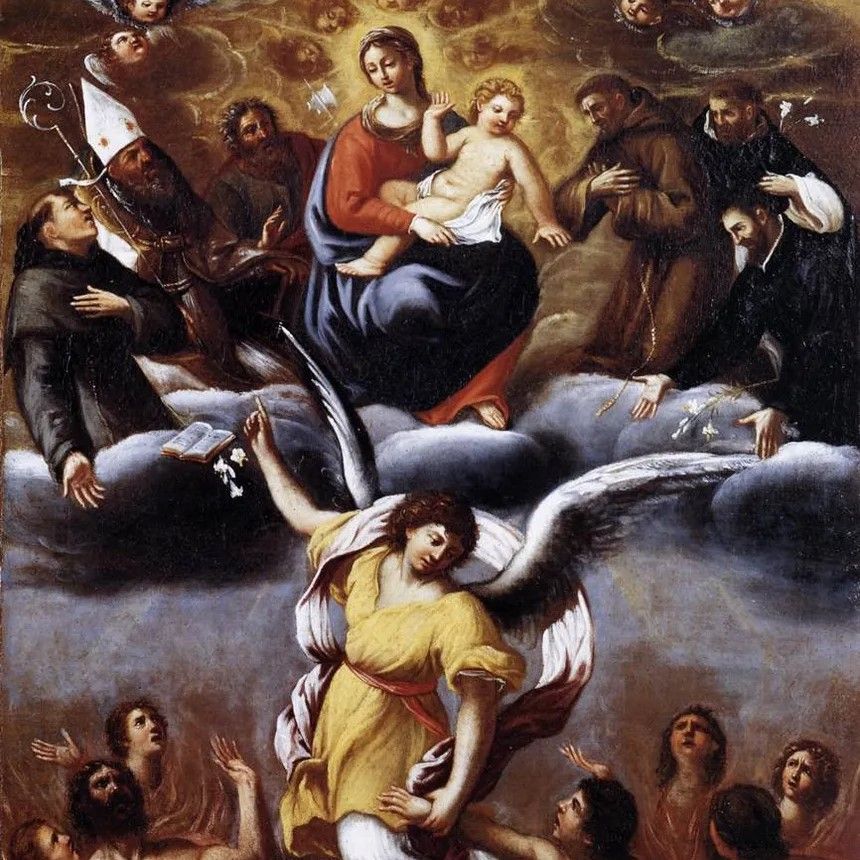
How we can help the Holy Souls in November? November is the month of the Holy Souls and so this is an important time during which to remember our own loved ones, and more generally the souls in Purgatory. Regarding purgatory in the Catechism we find this passage: “The Church gives the name Purgatory to this final purification of the elect, which is entirely different from the punishment of the ... the tradition of the Church, by reference to certain texts of Scripture, speaks of a cleansing fire” (1031). Jesus certainly spoke about hell as a place of fire, of eternal punishment, (e.g. Mark 9: 43, 47; Luke 16:19-31), and the Church has traditionally seen purgatory as a lesser form of punishment—since unlike hell it will end—but still, according to some of the saints, an extremely painful experience, to the extent that the pains of purgatory surpass anything we could experience on earth. Thus, we should live our lives with the aim of entering heaven when we die. In any event, we can help the souls in purgatory particularly in November, but also at any time of the year, by visiting a cemetery and praying for particular souls, either vocally or mentally, so as to gain a partial indulgence on their behalf. And to go further, a Plenary Indulgence may be gained between 1st and 8th November, applicable to the Holy Souls only, by visiting a cemetery and praying there for the dead, even if the prayer is only mental, and then fulfilling the conditions required, which are Confession, (up to eight days before or afterwards), Holy Communion, and prayer for the intentions of the Pope (one Our Father and one Hail Mary).
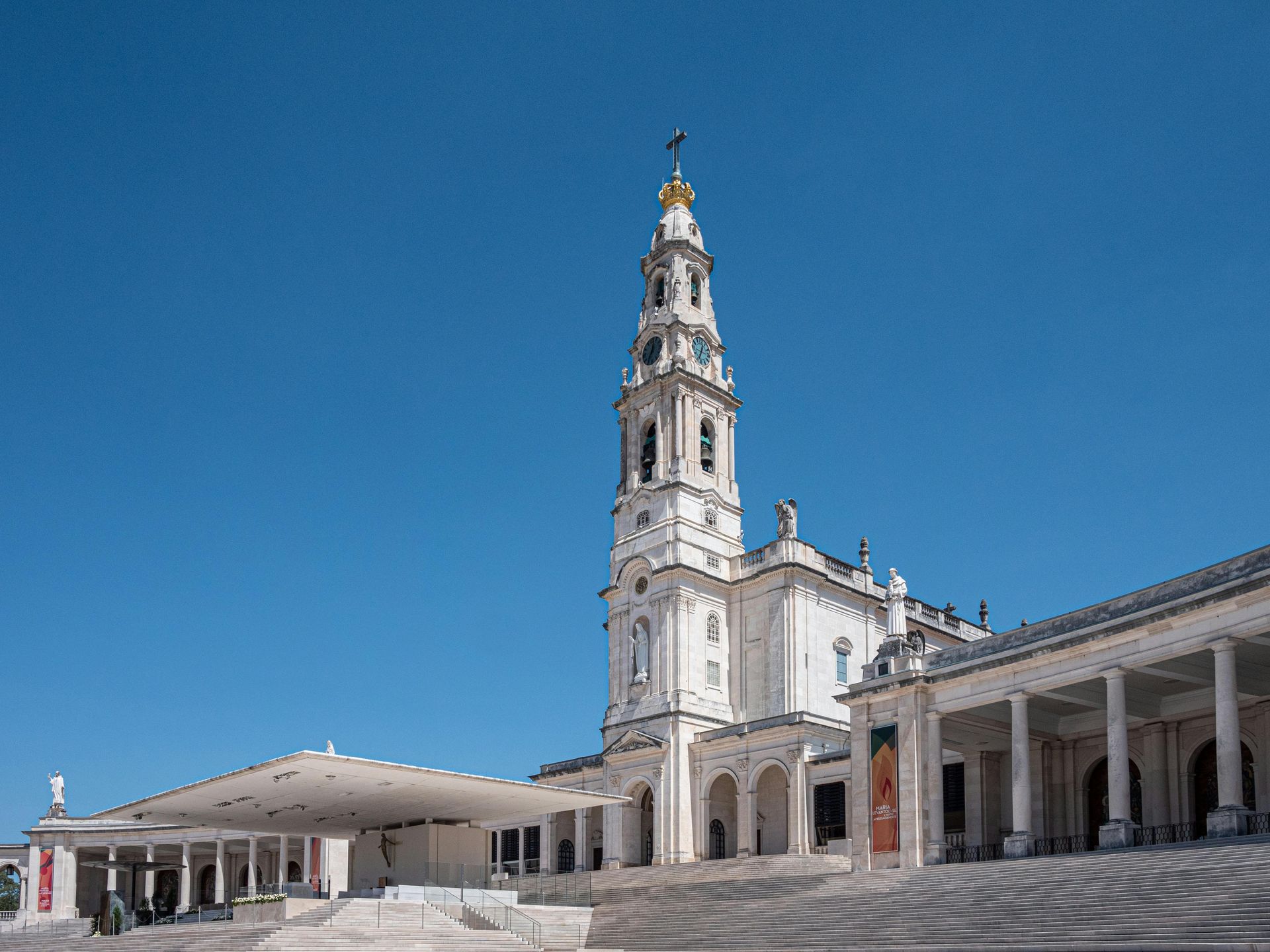
The connection between the request for Consecration, and the First Saturdays of Reparation in the Fatima Message, stating how each of them lean on the other Some background on Fatima’s historical context Our Lady appeared in Fatima, whilst the world was ravaged by an ongoing 4th year of War. Millions had needlessly perished, and the endless slaughter seemed unstoppable. Pope Benedict XV (1914-1922) had worked tirelessly to try to end the war diplomatically, but was ignored on every side. He labeled World War 1 as “the suicide of civilised Europe.” Russia suffered devastating defeats, which led to revolution by militant atheists, whose avowed aim was for world domination under communism. From March to November 1917, the Russian revolution annihilated the Czar, and all resistance, to the launch of the Soviet totalitarian State. The age of the greatest number of martyrs in the history of the Church was inaugurated. Pope Benedict XV promulgated a special Novena of Rosaries in Rome to plead the intercession of Our Lady Queen of Peace. It started on May 5th, 1917, entreating her for the end of the war. Nine days later on May 13th, Our Lady appeared in Fatima as if directly answering the Holy Fathers pleadings for peace. Heaven had listened, where no one else would! At the same time in Rome, Eugenio Pacelli was consecrated Bishop who would become Pope Pius XII in 1939. This Pope throughout his pontificate paid close attention to the message brought by the Mother of God. Our Lady appeared in Fatima, and asked that the Rosary be prayed daily for the end of the war, and for peace. She asked that sacrifices be made for the conversion of sinners, and to help spread devotion to her Immaculate Heart. Later she asked for two crucial things which she indicated would obtain the peace of the World, and the conversion of Russia - so that Russia would not continue to spread its errors throughout the world, annihilating nations, persecuting Christians, crucifying the Church, and causing much suffering to the Holy Father. Two crucial Requests as an antidote for War, and for the prevention of the spread of Communism! The message of Fatima highlights for us that Russia cannot be converted, nor can there be peace in the world, without Consecration to the Immaculate Heart of Mary, and establishment of devotion to the Immaculate Heart of Mary through the practice of the First Saturdays of Reparation. 1On July 13th 1917 Our Lady gave insight into the meaning of the need for reparation to her Immaculate Heart when she said: “Sacrifice yourselves for sinners, and say many times especially when you make some sacrifice: O Jesus, it is for love of You, for the conversion of sinners, and in reparation for sins committed against the Immaculate Heart of Mary.” As Our Blessed Mother said these words, she extended and opened her hands, as she had done during the two previous months, and showed the three young shepherds the terrifying vision of Hell. Lucia speaks: “The rays of light seemed to penetrate the earth, and we saw as it were a sea of fire. Plunged in this fire were demons and souls in human form, like transparent burning embers, all blackened or burnished bronze, floating about in the conflagration, now raised into the air by the flames that issued from within themselves together with great clouds of smoke now falling back on every side like sparks in huge fires, without weight or equilibrium, amid shrieks and groans of pain and despair, which horrified us and made us tremble with fear. (It might have been this sight which caused me to cry out, as people say they heard me.) The demons could be distinguished by their terrifying and repellent likeness to frightful and unknown animals, black and transparent like burning coals.” Our Lady then said with great sadness: “You have seen hell where the souls of poor sinners go. To save them, God wishes to establish in the world devotion to my Immaculate Heart. If what I say to you is done, many souls will be saved and there will be peace. The war is going to end; but if people do not cease offending God, a worse one will break out during the pontificate of Pius XI. When you see a night illumined by an unknown light, know that this is the great sign given you by God that he is about to punish the world for its crimes, by means of war, famine, and persecutions of the Church and of the Holy Father.” “To prevent this, I shall come to ask for the Consecration to my Immaculate Heart, and the Communion of Reparation on the First Saturdays. If my requests are heeded, Russia will be converted, and there will be peace; if not, she will spread her errors throughout the world, causing wars and persecutions of the Church. The good will be martyred, the Holy Father will have much to suffer, various nations will be annihilated. In the end, my Immaculate Heart will triumph. The Holy Father will consecrate Russia to me and she will be converted, and a period of peace will be granted to the world.” 2The Communion of Reparation on the First Saturdays, and the Collegial Consecration of Russia to her Immaculate Heart, led by the Holy Father in communion with all the Bishops of the world are the two crucial requests! One remains unheard, unpracticed and is hardly known - the First Saturdays of Reparation! If the Requests go unheeded! Our Lady foretold what might unfold if people did not convert and return to God - the tyranny of communism, that Russia would spread her evils throughout the world, that another War (World War II) could break out, that the good would be martyred, and that the Church would experience severe persecution. Russia it seemed was used as a symbol for all those who tried, and still try to eradicate God, through what ever atheistic systems and philosophies they can, to destroy the values of faith, the sanctity of marriage and family, and the sanctity of life from the moment of conception to natural death. Our Lord himself in 1936, said to Lucia, “If they do not wish to heed my request, as like the King of France, they will repent and do it, but it will be late. Russia will have already spread her errors throughout the world, provoking wars and persecutions of the Church. The Holy Father will have much to suffer.” The Light of Fatima and the Message Fatima is a light illuminating the darkness of our times. Its strong light has shone, since its dawning to the three little shepherd children in 1916/1917, and then onwards through the mission of Sr. Lucia in 1925 and 1929, and beyond to the present day. Fatima is a witness to faith. It is a mystical grace, which at our invitation, has the power to draw us into the mystery of the Most Holy Trinity, and an experience of the love of God. Fatima is at the same time prophetic, and a warning, a call to people to turn from sin, to change and to convert, and to embrace God in His loving Will. Fatima points to future events, but encouragingly demonstrates that our response to the calls of the Angel of Peace, Our Blessed Lady and Our Divine Lord through prayer, confession of sin, penance, reparation for sin, and consecrations to the Immaculate Heart of Mary, have the spiritual power to mitigate or even bring to naught the punishments which in justice are due because of the sin of the world. Fatima is an outpouring of God’s love and mercy for all people. Some of the first words of the Angel of Peace (1916) were, “The Hearts of Jesus and Mary have designs of mercy on you.” The Fatima Message is also presenting us with the Peace Plan of Heaven! Praying for the Salvation of Souls Jesus and Mary are pleading with us to pray for the salvation of souls, to save them from the fires of hell. What matters for all of us is Eternal Life … the destiny which Our Lord and Our Lady desire for each person. As the Catechism of Christian Doctrine (1985) said: What must you do to save your soul? To save my soul I must worship God by Faith, Hope and Charity; that is, I must believe in him, I must hope in him, and I must love him with my whole heart.” On August 19th 1917 Our Blessed Lady said: “Pray, pray very much, and make sacrifices for sinners; for many souls go to hell, because there are none to sacrifice themselves and to pray for them.” The Fatima Message teaches us how prepare for Eternal Life, and to plead for the salvation of those who do not believe, do not adore, and do not love God. Our Lady’s motherly concern in Fatima echoed the Catechism of the Catholic Church which states: “The chief punishment of hell is eternal separation from God, in whom alone man can possess the life and happiness for which he was created and for which he longs. The affirmations of Scared Scripture and the teachings of the Church on the subject of hell are a call to the responsibility incumbent upon man to make use of his freedom in view of his eternal destiny.” (CCC1036-1036) The request for the First Saturdays of Reparation Our Lady often appeared holding Her Heart which was encircled by piercing thorns. This demonstrated that Our Blessed Lady is outraged, and that she is seeking reparation. Reparation for sin is due in justice to God and neighbour. The more serious the sin, the greater the need for reparation. Yes, we go and confess our sins in the Sacrament of Confession. We are then given a penance. Reparation compliments the penance. Ven. Archbishop Fulton Sheen once gave this helpful analogy: Imagine a woodblock with a nail in it. When you go to Confession your sin is confessed and removed. Like the sin the nail is removed … yet what remains is the hole representing the wounds of sin! The wounds which need to be healed by acts of reparation. Think of a festering wound! It is no good placing a sticking plaster over it, and failing to treat it! Septicaemia is likely to follow, with death close at hand! The wound needs close attention paid to it, cleaning, purifying, and the prescription of medications to totally heal it. Like physical symptoms sin often leaves behind a trail, and we need to do something about it. Various acts of Reparation are our spiritual antidotes, 4and spiritual medications so that the wounds of our sin might be healed from their roots. Hence, Our Blessed Mother in Fatima asked us for a monthly Confession and acts of Reparation. They are a means to re evaluate our catholic practice and witness. A monthly confession helps all of us to examine our consciences in a more profound way. At the core of the devotion to the Immaculate Heart of Mary is the call to Penance, Penance, Penance, and Reparation, Reparation, Reparation, which preceded the request for the Consecration of Russia. In July 1917 Our Lady said: “Sacrifice yourselves for sinners, and say many times especially when you make some sacrifice; “O Jesus, it is for love of you, for the conversion of sinners, and in reparation for the sins committed against the Immaculate Heart of Mary.” Practice of the First Saturdays of Reparation - Heaven’s Peace Plan! Heaven's Peace Plan – 5 Days that have the potential to change you and bring peace to the World! Are you willing to help change the WORLD? Heaven's Peace Plan for the Church, Families and Nations was presented to us through the Messages of Our Lady of Fatima. It is a humble and peaceful plea - to pray the Rosary daily and to practice monthly the First Saturdays of Reparation. The Rosary and the First Saturdays are the great desire of both the Hearts of Jesus and Mary for these dangerous times. Heaven is pleading with sinful earth through these requests! Heaven's Peace Plan is seemingly so simple - so simple that most in the Church have missed it! The devotion can be done individually or communally. If done communally with others, it gives a powerful witness of faith to the rest of the Church. Sr. Lucia strongly stated in 1939: “War or Peace in the world depends on the celebration of this devotion (the First Saturdays), and the Consecration to the Hearts of Jesus and Mary connected to it …” On the First Saturday of every month – we are invited to undertake … 4 practices with 1 Great Intention. Each First Saturday we are asked to: 1. Go to Confession (on the day, or as soon as possible before or after) 2. Receive Holy Communion as a Communion of Reparation (in a state of grace) 3. Pray the daily Rosary 4. Meditate for 15 minutes on the Rosary Scriptures whilst keeping Our Lady company. All with the intention of making Reparation for sins committed against the Immaculate Heart of Mary, and which are so offensive to God. The First Saturday Apparition On December 10th, 1925, Jesus and Mary came to Lucia when she was a postulant in the Dorothean Convent in Pontevedra, Spain. Lucia had only joined the convent on October 26th 2025, just 6 weeks before. Lucia described it thus: “It was December 10, 1925. I was in my room, when suddenly the room lit up and it was the light of my dear Mother in Heaven who came with the Child Jesus a luminous cloud. Our Lady as if wanting to install courage, rested her hand on my shoulder, and as she did so, showed me her Immaculate Heart encircled by thorns, which she was holding in her other hand.” The child Jesus said, “Have compassion on the Heart of your Most Holy Mother covered with the thorns with which ungrateful men pierce it at every moment, and there is no one to make an act of Reparation to remove them." Then Our Lady said , “Look, My daughter, at My Heart surrounded with thorns with which ungrateful men pierce me at every moment by their blasphemies and ingratitude. You, at least, try to console me, and say that I promise to assist at the hour of death, with all the graces necessary for salvation, all those who, on the first Saturday of five consecutive months, shall confess, receive Holy Communion, recite five decades of the Rosary and keep me company for fifteen minutes while meditating on the mysteries of the Rosary, with the intention of making reparation to me.” Lucia further added: “After this grace, how could I take myself away from the least sacrifice that God asks of me to console the Heart of my beloved Mother in Heaven, happy that Mary depletes the bitter drops of the Chalice.” The First Saturdays are crucial and integral to the PEACE plan of Heaven. This message requesting the First Saturdays is the great Crown of the June 13th and July 13th messages given in Fatima in 1917 to Lucia, Jacinta and Francisco in which Our Lady said she would come to ask for the Consecration of Russia to her Immaculate Heart, and the Communion of Reparation on the First Saturdays. Immediately following the apparitions at Pontevedra, Sr. Lucia communicated Our Lady’s request to her confessor and to the Bishop of Leiria (Fátima), so that the devotion could be approved by the Church, which only happened officially in 1939. Lucia’s main concern was to have the devotion approved by the Church, and once the Church approved it, she left it to the Church to further spread it, although she would speak about it to the people she would meet privately. And then as if this was not enough! On February 15th 1926 Jesus himself appears to Lucia when she was bringing out the rubbish, and strongly rebukes her for not promoting the First Saturdays. Lucia infers that she had previously met him some days before. Poor Lucia, who was a postulant, and not exactly free to actively action the request. In all Jesus came three times asking for this devotion to be spread. This is remarkable! And yet 100 years on … we in the Church have hardly started this great work! Jesus might ask us … “And have you spread through the world what our heavenly Mother requested of you?” Why would we not want to practice, and spread the First Saturdays? A Day of Reparation, each month in every parish throughout the Church – would transform the Church and Nations, and be the means of the sanctification and salvation of millions. First Saturdays may be done individually, communally or in small groups as long as all the requirements are fulfilled. It is so humble a request – that most of us have managed to overlook it! 100 years ago on December 10th 1925 Jesus and Mary both requested them of us. Why 5 Saturdays? Our Lord revealed to Sister Lucia that the Devotion was in reparation for the five offences and blasphemies spoken against the Immaculate Heart of Mary: 1. Blasphemies against Her Immaculate Conception. 2. Blasphemies against Her Virginity. 7 3. Blasphemies against Her Divine Maternity, refusing, at the same time to receive Her as the Mother of mankind. 4. Blasphemies of those who publicly seek to sow in the hearts of children indifference, disrespect and even hate for this Immaculate Mother. 5. Blasphemies and offences of those who revile Her directly in Her Sacred Images. We have only to look at the various news channels, social media channels and the like to see how widespread these blasphemies have become in our own times. Sadly, daily, in countries like England, Ireland, Scotland, Wales, France, Canada, Spain, America, Australia, Nigeria & many parts of Africa, many parts of South America, Asia, India, Pakistan, the Middle East, we hear of churches being burnt to the ground, dreadful sacrileges being committed, statues being smashed, and peoples being murdered and terrorised in the most brutal of ways just because they are Christian. Never in history have such outrages and sacrileges been committed on such a massive scale. Never in history has the Blessed Sacrament been so outraged, as so few catholics believe in the real presence of Jesus in the Most Holy Eucharist, Body, Blood, Soul and Divinity. Never has there been such open disrespect in our Catholic Churches. In St. Peter’s, Rome, it seems that sacrileges and abominations occur. Recently a man urinated on the actual altar under the Baldachinno. This is totally shocking, outrageous, blasphemous, and sacrilegious. These types of outrages are becoming common place. Yet as catholics, are we outraged into reparation? The First Saturdays are the forgotten part of the Fatima message, and the most important for the peace of the world and for the salvation of souls. Jesus and Mary gave to us all, and to Holy Church, a monthly means of prayer of Reparation for the sins of the world, and a call for us to make a monthly confession and Communion of Reparation. Our prayer, fasting and sacrifice give the grace to awaken faith, repentance, hope and charity in those who do not believe, do not adore and do not know God. Prayer together with sacrifice offered to God for love of Him and neighbour is redemptive. Reparation is about putting love where there has been a hurt. Do we love enough to put Heaven’s humble plea into action? Do we believe that our participation in the First Saturdays can help change the world and bring peace? Jesus on the Cross made reparation for all our sins and reconciled us with the Father, but we too have to cooperate with this redeeming work on behalf of souls. This is what the request for the Five First Saturdays is all about - so let us get to work! A timely reminder! It seems that St. Carlo Acutis (1991-2006), and Our Lady of Fatima have a fascinating connection. St Carlo had a great love for the Eucharist and the Blessed Virgin Mary. He was a great devotee of Fatima, and of praying the daily Rosary. In the final year of his young life in 2006, St. Carlo was on pilgrimage in Fatima, and had a vision of the three young seers. St. Francisco especially asked Carlo for prayers of Reparation, and acts of sacrifice for sacrilege of the Eucharist, whilst Venerable Sr. Lucy reiterated the importance of the Five First Saturdays of Reparation, and expressly connected them to the world’s destiny. Carlo died from leukaemia in 2006 and was canonised by Pope Leo XIV in September 2025. Consecration to the Immaculate Heart of Mary Consecrating ourselves to the Sacred Heart of Jesus through the Immaculate Heart of Mary is at the very centre of the Fatima Message, and serves to strengthen the foundation of our spiritual response of Reparation as requested in the angelic visitations, the visitations of Our Blessed Mother, and finally in the post Fatima visitations to Sr. Lucia as an adult, by both Our Divine Lord Jesus and his Holy Mother Mary. Consecration and Reparation to the Immaculate Heart of Mary makes complete our devotion to the Sacred Heart of Jesus. Our Lady told the children that to save souls from hell, “God wants to establish in the world devotion to My Immaculate Heart.” Devotion to the Immaculate Heart of Mary already existed in the world before the Fatima apparitions but was little understood. What Jesus and Mary emphasised through the Fatima messages was the importance of ‘establishing in the world’ devotion to the Immaculate Heart of Mary. In other words to build up the practice of the devotion already present, and make it integral and visible, at the heart of the spiritual life of the Church in every parish. What exactly is an Act of Consecration? An Act of Consecration is a supernatural event. The origin and source of the Act of Consecration is in the spiritual authority of the Bishops before Almighty God. An Act of Consecration is a cry for help, the recognition of fault, and an appeal for mercy for a new beginning. An Act of Consecration means to set aside an individual, a family, a country, a parish, a school or a diocese for God’s purposes. An Act of Consecration 9means that we want to become Holy! A Consecration involves a conscious and total renunciation of sin. The better an Act of Consecration is prepared for with confession, repentance and reparation, by the faithful and clergy, the more fruitful it will be spiritually speaking. God is greatly pleased with such Acts of Consecration. The Highest form of Consecration is of the entire Church and the World, when the Pope undertakes it in communion with the Bishops. This is what Our Blessed Mother asked for in Fatima, and which took place on March 25th 1984 at the request of St. John Paul II. Catholics need to awaken and become holy - for this will give the evangelical witness which will win our peoples, nations and world to Christ! We have the task of daily giving to Our Blessed Lady and her Divine Son JESUS - our lives, and beloved Church, more beautiful and resplendent than they ever were before! Over the centuries these Acts of Consecration have been seen and witnessed as heroic Acts of Faith, often during times of great persecution, war and National upheaval. Throughout history we have witnessed extraordinary graces of intervention in their aftermath. Some people only see these Acts of Consecration as ‘devotions of the little ones (the anawim), of not much importance’ – they are not! They have been carried out by Popes, Cardinals, Bishops, Priests and Laity throughout the rich and complex history of the Catholic Church in all the nations where she is present. So please HEAR this, and not confuse it with just another devotional request! Fatima, and Acts of Consecrations to the Immaculate Heart of Mary by successive Popes Pope Pius XI supported the propagation of the First Saturdays. He inaugurated the Feast of Christ the King to counter anti-Christian regimes. Interestingly, on December 14th 1927, Pope Pius declared St. Therese of Lisieux Patroness of the Missions, while also naming her as Patroness of all the works for the conversion of Russia. Sr. Lucia’s pleas to him were not going unheard! On October 31st, 1942, Pius XII spoke to the Portuguese peoples. This radio broadcast ended with a Consecration of the World to the Immaculate Heart of Mary which was repeated in Rome on December 8th 1942, Solemnity of the Immaculate Conception. 10 On July 7th, 1952, Pius XII through his Apostolic Letter “Sacro Vergente Anno” to the Russian peoples - (“In the Sacred Year that is ending”) consecrated Russia to the Immaculate Heart of Mary, hoping for their salvation amidst the hostility of the Soviet regime towards religion. The Consecration came at the end of the letter, and the Pope addressed them as Dearest Russian Peoples. Consecration of the peoples of Russia to the Immaculate Heart of Mary - Pope Pius XII. “We, therefore, so that Ours and your prayers are answered more easily, and to give you a singular attestation of Our particular benevolence, as a few years ago we consecrated the whole world to the Immaculate Heart of the virgin Mother of God, so now, in a way very special, we consecrate all the peoples of Russia to the same Immaculate Heart. In the sure confidence that with the most powerful patronage of the Virgin Mary, the vows will happily come true as soon as possible, that We, that you, and all good people work for a true peace, for a fraternal harmony and due freedom for all, and in the first place to the Church; so that, through the prayer that We raise together with you and with all Christians, the saving kingdom of Christ, which is "the kingdom of truth and life, the kingdom of holiness and grace, the kingdom of justice, love and peace", triumphs in every part of the earth and is firmly established. And with suppliant invocation we pray to the same most clement Mother, so that she may assist each one of you in the present calamities and obtain from her divine Son that light which comes from Heaven, and implore for your souls that virtue and that strength, by which, sustained by divine grace, may you victoriously overcome every impiety and error. Amen.” Rome, at Saint Peter's, July 7, 1952, the feast of Saints Cyril and Methodius, XIV Year of Our Pontificate. PIO PP. XII Pope St. John XXIII, formerly Cardinal Angelo Roncalli, visited Fatima in 1956 as Patriarch of Venice. As Pope he decided not to reveal the third secret of Fatima in 1960 as the message had instructed. The Pope stated it was "advisable to preserve the mystery”. Pope Paul VI towards the end of the Second Vatican Council on November 21st 1964 referred to the consecration which Pope Pius XII had made, in reference to Fatima. He then announced that he would present the Shrine in Fatima with a Golden Rose (Nov 21st 1964). Sr. Lucia made it clear at these times that Our Lady’s requests had not been satisfied or fulfilled. 11 Pope St. John Paul II was the Holy Father who finally fulfilled what Our Blessed Lady asked for. The assassination attempt on his life on May 13th 1981, prompted him, whilst in hospital to request to read the document containing the secret of Fatima. As he reflected he realised that Our Lady of Fatima had saved him on the very anniversary of the first apparition. On May 13th 1982, Pope John Paul II went to Fatima to give thanks to Our Lady for saving his life, and to make the Act of Consecration. The Pope had asked to speak with Sr. Lucia before this but was not able to, in order to try to understand more fully Our Lady’s actual request. Only afterwards was the Pope able to speak with Sr. Lucia, and discovered that he had not fulfilled all that was necessary for the Consecration to be accepted. In the light of this 20 minute conversation, the Pope on December 8th, 1983, Solemnity of the Immaculate Conception, wrote a letter to all the Bishops of the Catholic Church inviting them to make the Consecration to the Immaculate Heart of Mary, with him, from wherever they might find themselves on March 25th (1984) Solemnity of the Annunciation of the Lord. Pope John Paul II made the solemn Act of Consecration before the renowned image of Our Lady of Fatima, which was sent to Rome at his own personal request. The statue was placed near the papal altar directly above the tomb of St. Peter. This is the only time a full collegial Act of Consecration has ever taken place in the history of the Catholic Church. This was the moment of grace which Heaven fully accepted. Sr. Lucia endorsed this with gratitude, and thanksgiving. When I watched the video of this Act of Consecration, I was moved by the spiritual power of it, in the person of Pope John Paul II. His entire person, eyes, heart and soul were fixated upon Our Lady of Fatima, and his vestments flowed gently in the wind, perhaps symbolising a forthcoming movement of the Holy Spirit, which will break forth upon the world, through the Motherly and powerful intercession of the Immaculate Heart of Mary. Pope John Paul II followed this momentous Act of Consecration by making a dramatic gesture of gratitude, for Our Lady saving his life. He offered the bullet which had targeted him, and shot him to the Bishop of Fatima, who had it embedded in the Crown of Our Lady of Fatima. It was the final jewel and most precious jewel in the crown, which fitted perfectly in its centre and heart. The Third Secret of Fatima was published by the Vatican on June 26, 2000, also during the pontificate of Pope John Paul II. The Vatican released the full text, which Sr. Lúcia dos Santos, the surviving visionary, affirmed was the complete vision, she had, under obedience, written down in 1944. It was published by the Congregation for the Doctrine of the Faith. It contained the 12full text of the vision, a handwritten version by Sr. Lúcia, and a theological commentary by Cardinal Ratzinger (later Pope Benedict XVI). Pope Benedict XVI consecrated the world's priests to the Immaculate Heart of Mary in Fatima, Portugal, on May 12, 2010 and, granted a Golden Rose to Our Lady of Fatima as a tribute of gratitude. Pope Benedict XVI said when praying before the Statue of Our Lady of Fatima: “It is a profound consolation to know that you are crowned not only with the silver and gold of our joys and hopes, but also with the ‘bullet’ of our anxieties and sufferings.” Pope Francis led a renewal of the Act of Consecration to the Immaculate Heart of Mary on both October 13th 2013, and March 25, 2022, a spiritual plea for peace amid the war between Russia and Ukraine. The act was intended as a gesture of the universal Church, asking for an end to the violence by entrusting humanity to the Queen of Peace. The Pope also called on communities to annually renew this consecration on that same date. Pope Francis presented a Golden Rose to Our Lady of Fatima during his visit to the shrine on May 13, 2017 to mark the centenary of the apparitions. Pope Leo XIV recently presented with love and devotion a Golden Rose to Our Lady of Fatima on Saturday October 11th 2025, amidst Jubilee celebrations of Marian Spirituality. Like St. John Paul II he asked that the statue of Our Lady of Fatima be brought to Rome for this spiritually important occasion. His Holiness led a special vigil of Prayer and Rosary for Peace from St. Peter’s. Then on Sunday October 12th during the closing Mass of the Marian Spirituality Jubilee, His Holiness solemnly Entrusted/ Consecrated the World, all of Humanity, especially your children who are tormented by the scourge of war, to the Immaculate Heart of Mary. It is curious that the catholic media made nothing of this, and if they did, they called it a prayer to Our Lady??? Very strange! Within days of this taking place, the historic Peace Plan for the Middle East was inaugurated, and signed on October 13th 2025, the very anniversary of Our Lady’s last appearance in Fatima to the three young shepherd children. A sign to us all that Our Blessed Mother is powerfully at work for the salvation of souls, and for the peace of the world, and that perhaps the practice of the First Saturdays is beginning to have an impact. How do the requests for Consecration and Reparation lean on one another? The fullness of the grace of an Act of Consecration is realised when the solemn Act of Consecration is fully prepared for by repentance, confession of sin, and prayers, fasting and sacrifices of reparation. We, the catholic 13faithful of today, need to take seriously the call of the Gospel for a radical personal, communal and national repentance and reparation for our own sins and those of our families, peoples and nations. We, the lay faithful and our bishops and priests need to rediscover this basic call! For it is only when we Catholics awaken and become holy that we can HOPE for the Conversion of Nations. The graces of an Act of Consecration lean on the fruitfulness of the response of individual, and communal acts of Reparation. An Act of Consecration on its own will not bring the graces from HEAVEN for which we all long for - the peace of Nations and the salvation of souls. Peace in the world lies initially in the sanctification of the priests and laity of the Catholic Church, where we grow in Faith, Hope and Charity. As we grow in love so the cardinal virtues of prudence, justice, fortitude, and temperance will take root, paving the way for empowerment in the Holy Spirit for apostolic action and evangelisation. The work and initiation of this great movement of repentance and reparation will happen when the Church finally endorses, and publicly proclaims the practice of the First Saturdays of Reparation. The world again stands on the brink of war - will you ENACT the Peace Plan of Heaven for the peace of the world? – It is in your hands! Fr. Donald Calloway, leaves us with this stark warning, as he relayed the following! ‘War is your fault’ My fellow Marian, Fr. Seraphim Michalenko, sometimes tells a story that a priest ministering in Japan shared with him in Rome. This priest was at an international gathering of Christians from across the world, attended by foreign dignitaries. The ambassador from Japan approached the priest and verified that the priest served in Japan, and was a Catholic priest, and then said: “War is your fault.” The priest was surprised and asked what the ambassador meant. The ambassador said, “You Catholics, all of you - we do not have peace in the world. It is your fault”. The priest said, “Ambassador, why do you blame us?” The ambassador said, “I’ve read about this. The Lady came to you at Fatima, right? That’s what you believe? She told you what to do to secure peace in the world. Well, there’s no peace in the world, so obviously you Catholics haven’t done it.” The priest had to acknowledge that the ambassador was correct, but still tried to protest, saying, “Isn’t peace everyone’s responsibility?” The ambassador was vehement. “No, she came to you Catholics. Not to Buddhists. Not to Hindus. She came to you, and it is your responsibility.” 14That ambassador had more faith than a lot of Catholics! But he’s right - Our Lady came and asked for specific things at Fatima. If we had listened to her, and did what she had asked, there would be peace in the world! Imagine if we had listened …. what a different world we would live in today! The Holiness of catholics in the Church matters Finally let us look at, and unpack the deeper meaning of the Prayers of Reparation given by the Angel of Portugal to Lucia, Jacinta and Francisco before the apparitions of Our Lady of Fatima began: My God, I believe, I adore, I hope, and I love You! I ask pardon of You for those who do not believe, do not adore, do not hope, and do not love You. Most Holy Trinity, Father, Son and Holy Spirit, I adore You profoundly. I offer You the most precious Body, Blood, Soul and Divinity of Jesus Christ, present in all the tabernacles of the world, in reparation for the outrages, sacrileges, and indifference by which He is offended. And through the infinite merits of His Most Sacred Heart, and of the Immaculate Heart of Mary, I beg of You the conversion of poor sinners. The Angel spoke of indifference! It matters how we behave in Church, and give witness to our Faith. It matters how we enter Church, and place our fingers in the Holy Water Stoop, and then make the sign of the Cross. Do we do it with loving intention, witnessing to our faith in Jesus Christ, the Most Holy Trinity? Do we genuflect with love, and reverence to the Blessed Sacrament? Do we genuflect with intention and care? As we enter into one of the benches do we immediately begin to commune with Jesus, or do we attract the attention of people we know ,and begin to chat, and disturb those endeavouring to commune with the Lord? How sad it must be for the Lord to see so many parish churches full of chattering people, treating our churches as if they are concert halls or council chambers? So many Catholics seem to have forgotten that Our Divine Lord dwells silently in the Blessed Sacrament awaiting our love, prayers and adoration. Need I say more! How do we receive Holy Communion? Are we approaching Holy Communion with faith, reverence and love whether on the tongue or in the hand as a throne? Are we receiving Jesus with reverence and love? After we have received Jesus, do we make the sign of the Cross? Do we return to our kneelers and deeply commune with Him? 15 And then we look at the outrages and actual sacrileges of the Holy Eucharist which so offend Our Lord. Receiving Holy Communion in a state of unconfessed serious sin, and sadly actual attacks on the Holy Eucharist, carelessness in handling the sacred Body and Blood of Christ, thefts of the Sacred Species, and sadly so much more ….. The prayers of Reparation of the Angel of Fatima are more needed today than when they were first uttered by the Angel in 1916. We would do well to meditate on these prayers often and pray them. It matters what witness we give in our churches to children and young people. It matters what witness we give in our churches to fellow catholics and to non believers! Why is it that so many people, especially young people in our churches, do not know how to genuflect, make the sign of the Cross, receive Holy Communion with reverence, or even know the basic prayers? The monthly First Saturdays of Reparation are a monthly means to bring this all before the Lord, and his Holy Mother in Reparation. They are a means to revaluate our catholic practice and witness. Pope St. John Paul II fulfilled Our Lady’s request for the Consecration of Russia on March 25th 1984. Pope Benedict XIV, Pope Francis and Pope Leo XIV have all made significant Acts of Consecration since, in times of Global crisis. The Pope’s have done their part, and continue doing their part! We need to do ours through the practice of the First Saturdays! Lucia when petitioning Pope John Paul II about the Consecration, wrote in 1982: “I humbly lament and beseech the Consecration of Russia to the Immaculate Heart of Mary in union with all the bishops of the world. So that this consecration is a bond of union of all the members of the Mystical Body of Christ, who with Mary, the Mother of Christ and Our Mother, offer to the Lord to complete the work of Redemption of the world.” This is beautiful, and invites us all to renew daily, this bond of union of all members of the Mystical Body of Christ with the Pope and Bishops of the world. We are in this together with Mary our Co Redemptrix who will obtain from God, the Conversion of Russia, and that of the whole world through the Reparation of the First Saturdays, and the graces obtained through the Collegial Act of Consecration of March 25th 1984, and other Acts of Consecration both before and after. Take note again! - the fragile peace accord for the Middle East was signed on the Feast of Our Lady of Fatima - October 13th 2025! Perhaps a sign that the graces of our First Saturdays are at work? Pray the Rosary daily for Peace & practice the First Saturdays of Reparation. The Peace of the World depends upon your response! Antonia Moffat October 2025 Background Reading 1. A Pathway Under the Gaze of Mary - Biography of Sister Maria Lucia of Jesus and the Immaculate Heart by the Carmel of Coimbra. 2. Inside the Light - Understanding the Message of Fatima by Sr. Angela de Fatima Coelho - Postulator for Venerable, Servant of God Sr. Lucia dos Santos, & previously for both St. Jacinta and St. Francisco. 3. Fatima and the First Saturdays - Communal First Saturdays publication 4. The Message of Fatima - by Sr. Lucia 5. Numerous other books by Sr. Lucia, various priests and WAF publications. I highly recommend the reading of the above books. Daily Prayer in preparation of the Centennial of the apparition of the Infant Jesus and His Virgin Mother (December 10th 1925) to the Venerable Servant of God Lucia dos Santos O Virgin Mother of God and my dearest Mother, Our Lady of Fatima of the Most Holy Rosary, I gaze upon your Sorrowful and Immaculate Heart pierced with so many thorns by the ingratitude and grievous sins of your children. I am deeply and forever sorry for how my sins have offended your Divine Son and you, His sinless Mother. With a humble and contrite heart, I wish to make reparation for the offences - great and small - given to your Heart by the sins of your children. In your maternal love, you have taught me, through your daughter, the Venerable Servant of God Lucia dos Santos, the way to make reparation for sins by the First Saturdays Devotion. On the occasion of the 100th Anniversary of your apparition, together with the Infant Jesus, to the Venerable Servant of God, on December 10, 1925, I pledge to observe the First Saturday of the month in heartfelt reparation for sins by the sacramental confession of my sins, by the worthy reception of Holy Communion, by the recitation of five decades of the Rosary, and by keeping company with you for fifteen minutes while meditating on the mysteries of the Rosary. Please intercede for me that my practice of the First Saturdays Devotion may redound to the salvation of many souls and to peace in the world. Help me also to bring your message of the First Saturdays Devotion to others. In obedience to your maternal counsel, may the Church throughout the world offer to you this loving act of humble and contrite hearts in sincere reparation for sins committed. I give my heart completely to your Sorrowful and Immaculate Heart and, with you, I rest my heart forever in the Most Sacred Heart of Jesus. With all my heart, I offer this prayer in Him Who alone is my salvation. Amen. Raymond Leo Cardinal Burke - September 8th 2025 - Feast of the Nativity of the Blessed Virgin Mary 17 Act of Entrustment to the Blessed Virgin Mary by Pope Leo XIV on occasion of the closing Mass in St. Peter's Square for the Jubilee of Marian Spirituality October 12th 2025 Holy Virgin, Mother of Christ our Hope, your caring presence in this Year of Grace accompanies and consoles us and gives us, in the dark nights of history, the certainty that in Christ evil is overcome and every person is redeemed by his love. Perfect disciple of the Lord, you have treasured all things of God in your heart. Teach us to listen to the word of God and to understand it interiorly so that we may walk confidently on the path of holiness. To your Immaculate Heart we entrust the whole world and all of humanity, especially your children who are tormented by the scourge of war. Advocate of grace, advise us on the path of reconciliation and forgiveness, do not fail to intercede for us, in joy and in sorrow, and obtain for us the gift of peace that we earnestly implore. Mother of the Church, welcome us kindly, so that under your mantle, we may find refuge, and be helped by your maternal aid in the trials of life. With you, Immaculate Virgin, we magnify the Lord, recognising at every moment the great works of his love. Holy Virgin, Mother assumed into Heaven, Queen of Peace, Lady of the Immaculate Heart, pray for us!

